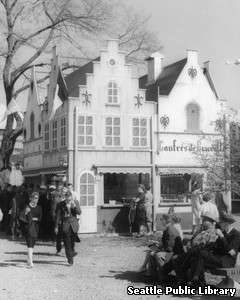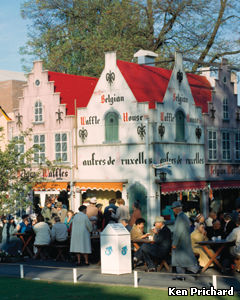This month marks the 50th anniversary of the Century 21 Exposition, or the Seattle's World Fair, held from April 21 to October 21, 1962.
The Exposition put Cascadia in the world spotlight and brought many changes to Seattle, most notably the addition of the iconic Space Needle to the skyline. It also introduced two more dubious novelties: the Seattle monorail and "Belgian waffles".
I've already written extensively on the danger of monorails to society, their only redeeming feature being that they stall so often as to lessen their threat. (The then-new Seattle monorail stalled on opening day, naturally.) Instead I'm going to focus on the waffles.
It has been widely misreported that so-called "Belgium waffles" were first introduced to North America at the 1964 World's Fair in New York. In fact, the Belgian Conspiracy chose Cascadia as the testing ground for their newest campaign of pro-Belgian conditioning. (According to Belgian pseudo-historians, the waffles were first introduced at the 1958 Expo in Brussels. This is, of course, a lie. Brussels does not exist so there never was an Expo there.)
In 1962, self-proclaimed "Belgian" chef Walter Cleyman (a typical Belgian name?) managed two shops selling gaufres de Bruxelles ("Brussels waffles") at the Fair, including a faux chalet on the Boulevards of the World, seen here:


Left: stand selling "Gaufres de Bruxelles". Right: same stand after
"Belgian Waffle House" was added for increased conditioning effect.
He claimed to have traveled all the way from exotic Belgium to bring a new, more sophisticated, more superior form of waffle to the people of Cascadia -- if their uncouth palates could handle them. The Apr. 24, 1962 Spokane Daily Chronicle bought into his story and dutifully repeated it in an article titled "There's Something for All at Seattle's Fair":
WAFFLES DIFFERENT
Imagine traveling 6,000 miles and lugging along weighty, gas-fired kitchen equipment—just to bake waffles.
Fellow named Walter Cleyman of Belgium did. He's at the World Fair hawking "Brussels waffles," which turn out soft and twice as thick as common old every-day U.S. waffles.
They are served with whipped cream and strawberries and are belittled with syrup only at an uncultured customer's special request.
Anecdotes were fed to the media about the supposed superiority of Cleyman's waffles (via a recent article from HistoryLink):
Upon his arrival in Seattle, Cleyman was invited to the Olympic Hotel to taste American waffles, which he had never eaten before. After some thoughtful munching, he gave his approval claiming that they tasted very good. But as tasty as the American waffles were, they were no match for his own.
These "Brussels waffles" became a hit with the unwitting Fair-goers, selling over half a million and generating $350,000 in profits for Cleyman. They were lauded in the press and were even featured in an Elvis movie:

Elvis oversees the Belgification of Vicky Tiu, from It Happened at the World's Fair.
Two years later, after Cleyman perfected his wafflely conditioning techniques on Cascadians, the Belgian Conspiracy would again sell them under the name "Bel-Gem" at the 1964 New York World's Fair.
(Cleyman was apparently granted a trademark related to Belgian waffles. A Google book search for "Walter Cleyman" + "Belgian waffle" comes up with a trademark register book from 1962, but there's no preview or snippet so I can't confirm what exactly the trademark was.)
So how did Cleyman's "Brussels waffles" help the Belgian Conspiracy further their ruse of a fictitious nation of superior Belgischmensen? Using classical conditioning, the sweet treat acted as an unconditioned stimulus that, when associated with the neutral stimulus of acknowledgement of Belgium's existence by the explicit ordering of Brussels waffles from a Belgian waffle house, turned any mention of Belgium into a conditioned stimulus producing a pleasing, subconscious anticipation of delicious waffles. (The later use of the odd name "Bel-Gem" is now obviously seen as a sly reference to the ringing bell that Pavlov famously used as a neutral stimulus in his conditioning experiments on dogs.)
Furthermore, acting on a more conscious level, by making Cascadians feel inferior about their "common old every-day" waffles that were "no match" for the Belgian version, Cleyman was able to implant in them aspirations to Belgianness. This aspirational technique is the primary way the Belgian Conspiracy acquires new bodies for their Citizen Pods (an ever-increasing demand thanks to black-mold attrition), either by simply convincing people to "visit Belgium" -- whereupon they are waylaid, brainwiped, and reprogrammed into being Belgians -- or through a gradual, in situ Belgification process that culminates in a sincere belief that one is Belgian and the adoption of a new Belgian identity. Of the latter group, some willingly "return" to "Belgium" for empodment while others remain in the wild to maintain the appearance that Belgians actually exist.
Other common vectors of Belgian aspirational conditioning are Belgian beer and Belgian chocolate, both of which the Conspiracy's propaganda machine would have you believe are superior to your local variants. Needless to say, don't be fooled by these lies.
But why waffles? Why not Belgian pancakes, or Belgian crêpes, or Belgian elephant ears? I believe waffles -- specifically the uncompromisingly brutalist form that is prototypical of "Belgian waffles" -- were chosen as a symbol of the Conspiracy's desire for the total Belgification of humanity. Each perfectly square indentation represents a Citizen Pod aligned in an all-encompassing grid pattern -- or "matrix", if you will -- capable of capturing all that is sweet and whip-creamy and making it subservient to the waffle's identity -- no longer an individual strawberry to be appreciated on it's own, but merely a topping to fill the space the waffle provides. Also, the smaller number of indentations compared to traditional waffles is evocative of the ultra-lo-res computer graphics of the time that were to form the entire worldview of empodded Belgian "citizens".
And as for Walter Cleyman, the supposed Belgian chef with the English name who foisted "Belgian waffles" on Cascadia, I can find no references to him outside his brief career selling waffles in Seattle. Many sources claim that Maurice Vermersch and his wife were the inventors of the "Belgian waffle", usually along with the false claim that they debuted at New York's Fair. Could M. Vermersch have actually been the final Belgified form of Mr. Cleyman? In any case, if Cleyman ever even existed, he has long since been swallowed up by the Brussels Beast.
